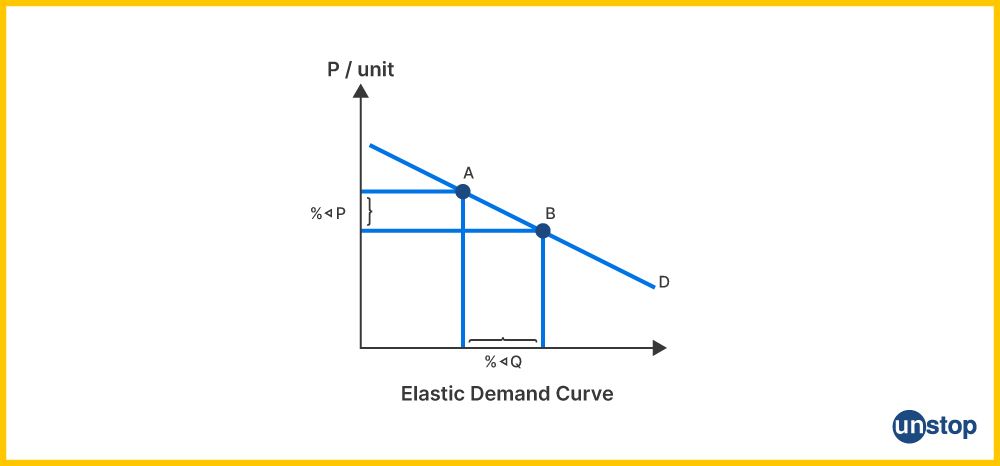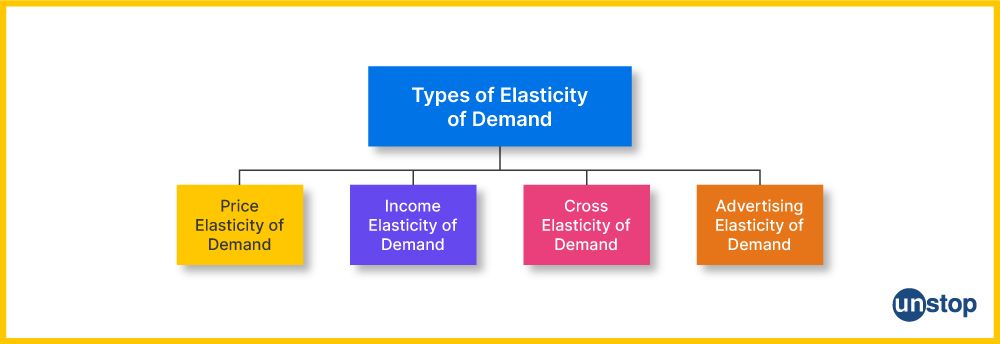- What is Elastic Demand?
- Factors Determining Elasticity of Demand
- Types of Elasticity of Demand
- Price Elasticity of Demand
- Cross Elasticity of Demand
- Income Elasticity of Demand
- Elasticity vs. Inelasticity of Demand
- Frequently Asked Questions (FAQs)
What Is Elastic Demand?: Understanding Its Factors & Types With Examples

Demand and supply are fundamental concepts in economics. Demand refers to the quantity of a product or service that consumers are willing and able to purchase at a given price, while supply refers to the quantity of that product or service that producers are willing and able to provide at a given price. The interaction between demand and supply determines the equilibrium price and quantity in a market, influencing business decisions such as pricing, production, and resource allocation.
So, what is elastic demand?
Elastic demand is the sensitivity of consumer demand to changes in price. By understanding elasticity, which measures how much quantity demanded changes in response to a change in price, businesses can anticipate and respond effectively to shifts in consumer behavior.
Elastic demand helps explain market dynamics and consumer purchase patterns, shedding light on how brands can adjust their pricing strategies accordingly. In contrast, inelastic demand refers to situations where price changes have minimal impact on consumer demand.
Here, we will delve into the concept of elastic demand, explore its implications for businesses, and understand its types.
What is Elastic Demand?
Elastic demand refers to a situation where a small change in price leads to a significant change in quantity demanded.

Let’s understand this with some examples.
Example of Elastic Demand
Gasoline and movie tickets are prime examples of products with relatively elastic demand. When the price of gasoline rises, consumers tend to be more sensitive to the increase and may seek out alternatives. This is because there are acceptable substitutes available, such as public transportation or electric vehicles. As a result, even a small increase in price can lead to a significant decrease in the quantity demanded.

Image credit: freepik
Similarly, movie tickets often exhibit elastic demand. If ticket prices rise too high, consumers have the option to choose alternative forms of entertainment like streaming services or renting movies. This makes them more likely to reduce their movie theatre visits or opt for cheaper options like matinee showings. The availability of substitutes contributes to the elasticity of demand in this case.
Example of Inelastic Demand
On the other hand, products like salt or water typically have inelastic demand. These goods are considered necessities and have few acceptable substitutes available. Regardless of price increases, customers still need these products for daily use and are less likely to change their buying habits significantly.

Image credit: freepik
Products that display both elastic and inelastic demand
Electronic gadgets, such as smartphones, can display both elastic and inelastic segments depending on various factors. For example, their demand tends to be less responsive to price changes (inelastic). However, for mid-range or budget-friendly smartphone brands that cater to a wider consumer base with lower income levels and less brand loyalty, their demand may exhibit more elasticity.
Unity elastic, Perfectly inelastic and Perfectly elastic demand

Perfectly inelastic demand refers to a situation where the quantity demanded remains constant regardless of price changes. This typically occurs with goods that are considered essential or life-saving, such as medications for critical illnesses. In these cases, people are willing to pay any price to obtain the necessary product because their health or well-being depends on it.
On the other hand, perfectly elastic demand is observed when even a slight change in price leads to an infinite change in the quantity demanded. This usually happens with generic commodities that have many close substitutes available in the market. Consumers can easily switch to alternative products if there is a small increase in price, resulting in a significant decrease in demand for the original product.
Perfectly elastic demand example: Imagine a situation where you need a specific type of screw for a project. Brand A's screws are priced slightly higher than Brand B's. Since the screws offer the same functionality, most consumers would likely switch to the cheaper option with minimal hesitation. This scenario reflects near-perfect elasticity.
While perfectly inelastic and perfectly elastic demand represent two ends of the spectrum, most real-world products fall somewhere between these extremes.
Unity elasticity refers to a situation in economics where the demand for a product or service is perfectly responsive to changes in price. In other words, when the price of a product or service changes, the quantity demanded changes in the same proportion. This means that the elasticity of demand is equal to 1.
For example, if the price of a good increases by 10%, the quantity demanded will decrease by exactly 10%. Similarly, if the price decreases by 10%, the quantity demanded will increase by exactly 10%. Unity elasticity is often used as a benchmark to compare the responsiveness of demand for different products or services.
Factors Determining Elasticity of Demand
Several factors determine the elasticity of demand, such as:
Price Relative to Income
One factor influencing demand elasticity is the price relative to income. If a product's price represents a significant portion of a consumer's income, they are more likely to be sensitive to changes in price and adjust their purchasing behavior accordingly. On the other hand, if the price is relatively low compared to income, consumers may not be as responsive to price changes.
Availability of Substitutes
The availability of substitutes also affects demand elasticity. When there are many alternatives or substitutes available for a particular product, consumers have more options and can easily switch between them based on price fluctuations. In such cases, demand tends to be more elastic because consumers can easily substitute one product for another.
Necessity vs Luxury Goods
Another factor that influences elasticity is whether a good is considered a necessity or a luxury item. Luxury goods tend to have more elastic demand compared to essential goods. For example, if the price of high-end designer clothing increases significantly, consumers may choose less expensive alternatives or delay their purchases altogether. In contrast, essential goods like food or medicine often have inelastic demand because they are necessary for daily living, and consumers are less likely to cut back on these items even if prices rise.
Time and Adjustments
Time also plays a role in determining elasticity. Over time, consumer behavior may change as they adapt and adjust their purchasing habits based on changing prices. Initially, consumers may continue buying a product despite an increase in price due to habit or lack of immediate alternatives. However, over time, they might seek out cheaper options or reduce their consumption if prices remain high.
Types of Elasticity of Demand

Different types of elasticity are used for analysis purposes, including price elasticity, income elasticity, cross-price elasticity, and advertising elasticity. Each type measures the responsiveness of quantity demanded or supplied based on specific variables or factors. Here are the four main types of elasticity of demand:
- Income Elasticity of Demand (YED): Measures the responsiveness of quantity demanded based on changes in income. Example: If the YED for a luxury car is 2, it means that a 1% increase in income will result in a 2% increase in the quantity demanded for the car.
- Price Elasticity of Demand (PED): Measures the responsiveness of quantity demanded based on changes in price. Example: If the PED for a product is -1.5, it means that a 1% increase in price will result in a 1.5% decrease in the quantity demanded for the product.
- Cross Elasticity of Demand (XED): Measures the responsiveness of quantity demanded based on changes in the price of a related good. Example: If the XED between coffee and tea is 0.8, it means that a 1% increase in the price of coffee will result in a 0.8% increase in the quantity demanded for tea.
- Advertising Elasticity of Demand (AED): Measures the responsiveness of quantity demanded based on changes in advertising expenditure. Example: If the AED for a brand of soda is 1.2, it means that a 1% increase in advertising expenditure will result in a 1.2% increase in the quantity demanded for the soda.
Understanding these different types of elasticity is crucial for businesses as it allows them to evaluate market conditions and make strategic decisions accordingly.
By analyzing price elasticity, companies can determine how sensitive consumers are to changes in prices and adjust their pricing strategies accordingly. Income elasticity helps businesses understand how changes in consumers' incomes impact their demand patterns and adjust their marketing efforts accordingly.
Cross-price elasticity provides insights into the relationship between two different goods or services. It helps businesses understand whether two products are substitutes (when an increase in the price of one leads to an increase in demand for the other) or complements (when an increase in the price of one leads to a decrease in demand for the other).
Advertising elasticity helps measure how changes in advertising expenditure impact product demand. It enables companies to assess the effectiveness of their advertising campaigns and allocate resources accordingly.
Price Elasticity of Demand
Price elasticity of demand refers to how sensitive the quantity demanded is to changes in price alone. It helps businesses understand how consumers react to price changes, which is crucial for determining optimal pricing strategies and forecasting revenue changes.
High Price Elasticity
When the price elasticity of demand is high, it means that small price changes lead to significant shifts in the quantity demanded. This typically occurs with luxury goods or non-essential items. For example:
- Luxury cars: A slight increase in the price of luxury cars can result in a sharp decline in demand because consumers have alternatives and can easily switch to other brands or models.
- Designer clothing: Higher prices for designer clothing may discourage buyers from purchasing those items, as they can find similar styles at lower prices elsewhere.
Low Price Elasticity
On the other hand, when the price elasticity of demand is low, it implies that price changes have minimal impact on the quantity demanded. This often applies to essential goods or products with limited substitutes. For instance:
- Essential medications: Even if there is an increase in the price of essential medications, people will still continue to buy them because they are necessary for their well-being.
- Basic food items: The demand for staple food items like rice or bread remains relatively stable regardless of small fluctuations in their prices since they are necessities.
Cross Elasticity of Demand
Cross elasticity of demand, also known as XED, is a measure that helps us understand how the quantity demanded for one product changes in response to changes in the price of another related product. It reveals the relationship between two goods and their impact on each other's demand.
Positive cross elasticity indicates substitute goods, meaning that when the price of one product increases, consumers tend to shift their demand towards the other product. For example, if the price of coffee rises significantly, people may start buying more tea instead. On the other hand, negative cross elasticity suggests complementary goods. This means that when the price of one product increases, it leads to a decrease in demand for another related product. A classic example would be if the price of hot dogs goes up, people might buy fewer hot dog buns.
Understanding cross-elasticity is crucial for businesses as it enables them to identify market relationships. By analyzing XED values, companies can determine whether their products are substitutes or complements and make informed decisions about pricing and promotions.
For instance:
- Suppose a company discovers that its product has a high positive cross elasticity with a competitor's product (indicating they are substitutes). In that case, it might consider lowering prices or offering discounts to attract customers.
- Conversely, if two products have a high negative cross elasticity (indicating they are complements), adjusting prices or bundling them together could be effective marketing strategies.
Income Elasticity of Demand
Income elasticity of demand measures the responsiveness of quantity demanded to changes in income levels. Income elasticity of demand (YED) is calculated as the percentage change in quantity demanded divided by the percentage change in income. It helps us understand whether a good or service is normal, inferior, or luxury based on consumers' income levels.
Types of Income Elasticity
- Positive Income Elasticity: When YED is greater than zero, it indicates that the good/service is a normal good. As income increases, people tend to buy more of these products.
- Negative Income Elasticity: If YED is less than zero, it suggests that the good/service is an inferior good. As income rises, people tend to buy fewer of these items.
- Zero Income Elasticity: When YED equals zero, it implies that the product's demand remains unaffected by changes in income.
Examples and Applications
To better understand the income elasticity of demand, let's look at a few examples:
- Necessities like food and utilities typically have low-income elasticities because they are considered essential goods.
- Luxury items such as expensive vacations often have high-income elasticities since they are heavily influenced by changes in disposable income.
Understanding YED has various applications:
- Businesses can use this concept to predict consumer behavior and adjust their marketing strategies accordingly.
- Governments can utilize YED to develop policies that target specific industries or demographics based on their consumption patterns.
Elasticity vs. Inelasticity of Demand: An In-depth Comparison
Elastic demand and inelastic demand are two concepts that help businesses understand how consumers respond to changes in price. Here’s a look at how the two differ from each other:
| Criteria | Elastic Demand | Inelastic Demand |
| Definition | A small change in price leads to a large change in the quantity demanded. | A price change has a relatively small impact on the quantity demanded. |
| Response to price change | More responsive to price changes | Less responsive to price changes. |
| Price Elasticity | Higher price elasticity of demand | Lower price elasticity of demand. |
| Application | Typically occurs for goods or services that are not necessities and have readily available substitutes | Typically occurs for goods or services that are necessities and have limited substitutes. |
| Demand Curve | Tends to have a flatter demand curve. | Tends to have a steeper demand curve. |
| Sensitivity to income change | More sensitive to changes in income. | Less sensitive to changes in income. |
| Commonality | More common in the long run. | More common in the short run. |
| Example | If the price of a popular smartphone increases slightly, consumers may choose to buy a cheaper alternative or delay their purchase altogether. | Examples of products with inelastic demand include essential goods like food and medications. |
Understanding whether a product has elastic or inelastic demand is vital for forecasting sales, setting prices, and making informed marketing decisions. It helps businesses tailor their strategies based on consumer behavior and market dynamics.
Having a solid understanding of elastic demand empowers businesses to adapt their strategies based on market conditions. By analyzing price sensitivity and consumer behavior patterns through various forms of elasticity measurement, companies can optimize their pricing structures and identify growth opportunities. It is important to remember that each industry and product may exhibit different levels of elasticity; therefore, conducting thorough market research tailored to specific contexts becomes paramount in harnessing the power of elastic demand.
Frequently Asked Questions (FAQs)
1. How does price elasticity of demand affect pricing decisions?
The price elasticity of demand measures how sensitive consumer demand is to changes in price. When the price elasticity is high (elastic), even small changes in price lead to significant shifts in quantity demanded. This information helps businesses determine optimal pricing strategies by identifying the point at which revenue maximization occurs or when prices need adjustment without adversely impacting sales volume.
2. Can you provide an example illustrating cross elasticity of demand?
Cross elasticity of demand measures how changes in the price or availability of one product impact the quantity demanded for another product. For example, if there is a decrease in the price of smartphones (Product A), we may observe an increase in the quantity demanded for phone cases (Product B). This positive cross-elasticity indicates that these two products are complementary goods.
3. How does income elasticity impact luxury goods?
Income elasticity measures how changes in income affect the quantity demanded for a particular product. Luxury goods typically exhibit high-income elasticity, meaning that as consumers' incomes rise, demand for these goods increases at a higher rate than their income. This knowledge helps luxury brands tailor marketing strategies to target specific consumer segments and anticipate fluctuations in demand.
4. What is the difference between perfectly inelastic and perfectly elastic demand?
Perfectly inelastic demand refers to a scenario where the quantity demanded remains constant regardless of price changes. This is usually the case for essential goods or products with no close substitutes. On the other hand, perfectly elastic demand occurs when even slight price changes lead to an infinite change in the quantity demanded. In this situation, consumers have numerous substitute products readily available.
5. How does understanding elasticity benefit businesses?
Understanding elasticity allows businesses to make data-driven decisions regarding pricing, production levels, and marketing strategies. By analyzing consumer responsiveness to price changes and cross-product relationships, companies can optimize revenue generation, identify market opportunities, and respond effectively to changing economic conditions.
Suggested Reads:
I’m a reader first and a writer second, constantly diving into the world of content. If I’m not writing or reading, I like watching movies and dreaming of a life by the beach.
Login to continue reading
And access exclusive content, personalized recommendations, and career-boosting opportunities.
Subscribe
to our newsletter
















Comments
Add comment